Georges Island – Halifax’s Hottest New Destination
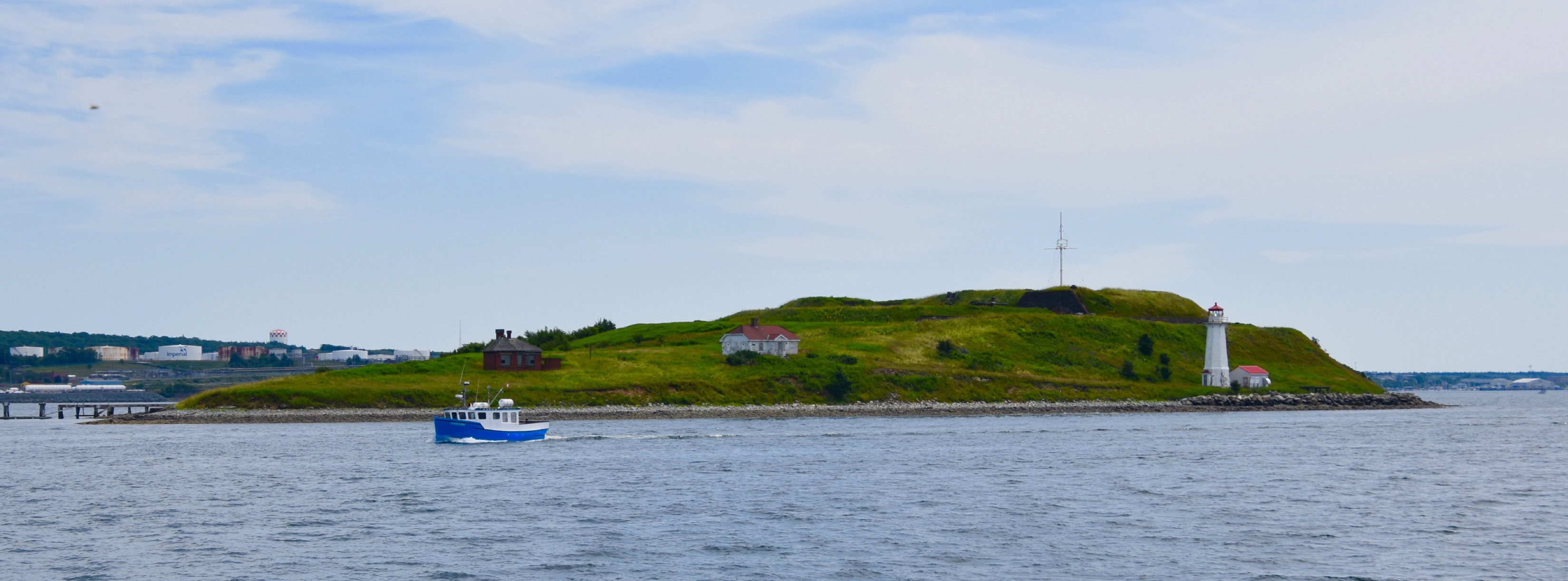
For more years than I care to remember, I would stroll the Halifax waterfront and stare out at Georges Island and wonder what it would be like to actually set foot on this historic and mystery shrouded place. Up until the summer of 2020 that’s all one could do other than take a photo like the one above from the closest point of land on the Halifax boardwalk. Off limits to civilians for literally centuries, Parks Canada finally opened Georges Island National Historic Park to the public and it is now one of the hottest tickets in town. It turns out that pretty well everyone in the metro area had the same longings as I did to visit and during this summer of Covid restrictions. Georges Island is the perfect outdoor getaway. Here’s why you need to visit Georges Island and how to do it.
History of Georges Island
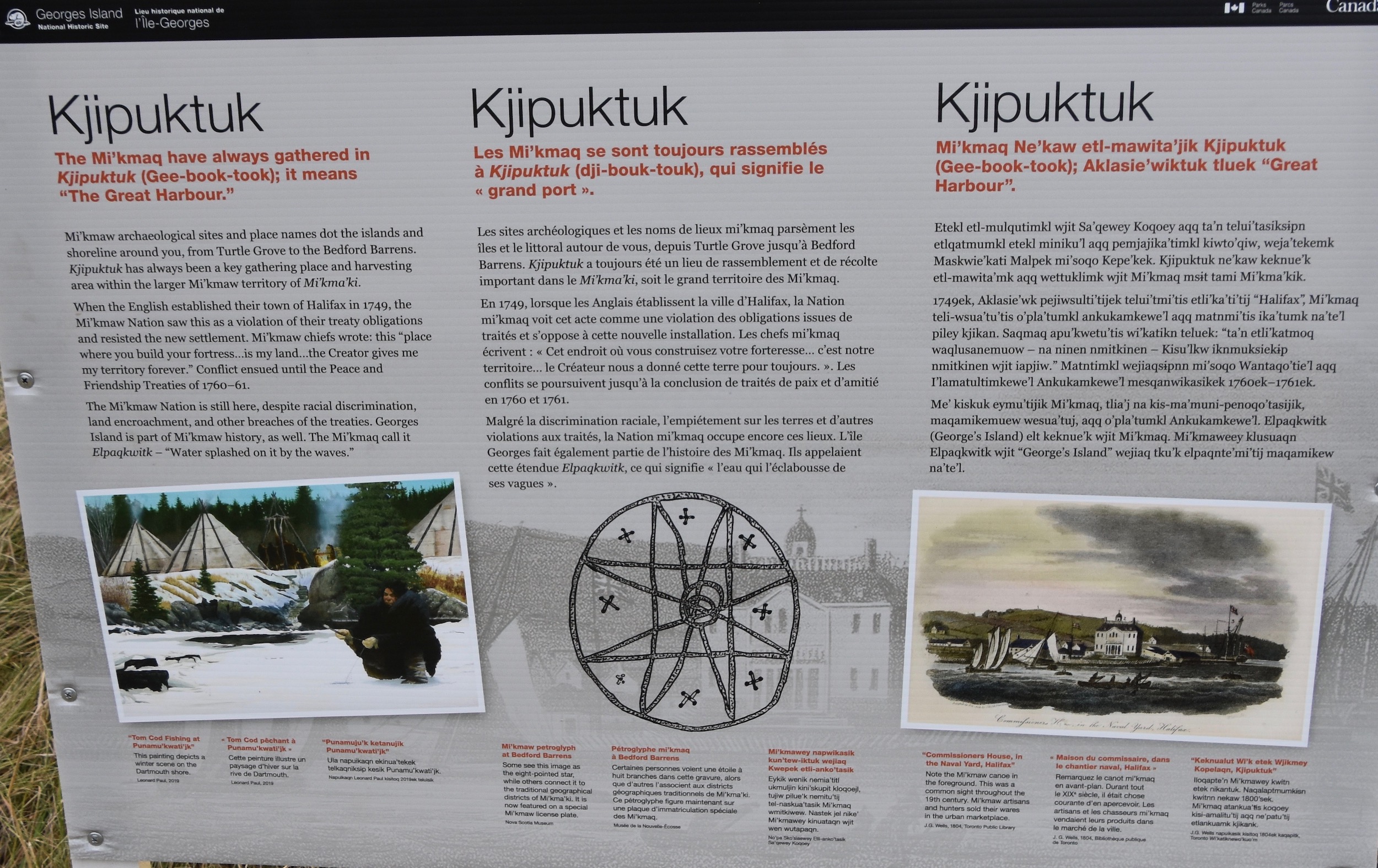
As landforms go, Georges Island (note there is no apostrophe) is a relative baby, dating back only to the last Ice Age which ended just over 10,000 years ago. As the glaciers receded they left behind teardrop shaped deposits of boulders, clay, gravel and earth called drumlins of which Georges Island is one. It’s much larger big brother is the drumlin we now call Citadel Hill.
Very soon after the ice was gone, the first Indigenous peoples arrived and took advantage of the natural resources that abounded in one of the largest ice free harbours in the Western Hemisphere, naming it Kjipuktuk or in English, ‘The Great Harbour”. The original Mi’kmaq name has evolved over the years to be pronounced as the word ‘Chebucto’ which appears in many places throughout the greater Halifax/Dartmouth area. The first name for Georges Island was Elpaqkwitk meaning ‘Water splashed on it by waves’ and archaeological evidence of human occupation dates back millennia.
Many people mistakenly believe that the first European use of Halifax harbour occurred in 1749 when Edward Cornwallis arrived with over a thousand prospective immigrants and formally established a settlement at the base of Citadel Hill. In fact, Europeans, mostly French, had been fishing and fur trading in the area since the 1600’s. They had a different name for the tiny island that sits almost exactly in the middle of the harbour – Ile de la Raquette because it was shaped like a snowshoe. The first momentous historical event on Georges Island occurred in 1746 when a huge French armada under the command of the Duc D’Anville was sent to recapture Fortress Louisbourg and drive the English out of all of North America, using Halifax Harbour as the staging ground. Faring no better than the Spanish in 1588, the expedition was an unmitigated disaster. Between ferocious storms and an outbreak of disease, thousands died and are buried in as yet unfound graves somewhere around what is now Birch Cove in Bedford Basin. D’Anville also died and was buried on George’s Island. Later his remains where transported to Fortress Louisbourg and you can visit his final resting spot in the chapel in the Governor’s Palace.
When Cornwallis did arrive three years later, the strategic importance of the little island in the harbour was recognized. Now named Georges Island after King George II, the first of many fortifications was constructed. These continued in one form or another right up until the end of WWII with the result that today the island is honeycombed with tunnels, underground batteries, storehouses and other manmade structures that were never open to the public during the time they were in active use.
The island’s history took a dark turn very early on during this military period. It was used as Halifax’s first prison and played a role in the expulsion of the Acadians during the Seven Year’s War. Up to 900 Acadians were imprisoned here before being transported to Europe, the West Indies or Louisiana. Many died on Georges Island before the transports arrived. Today nothing is left of the two large sheds where the Acadians were held, but their position is indicated on the island map that all visitor’s receive.
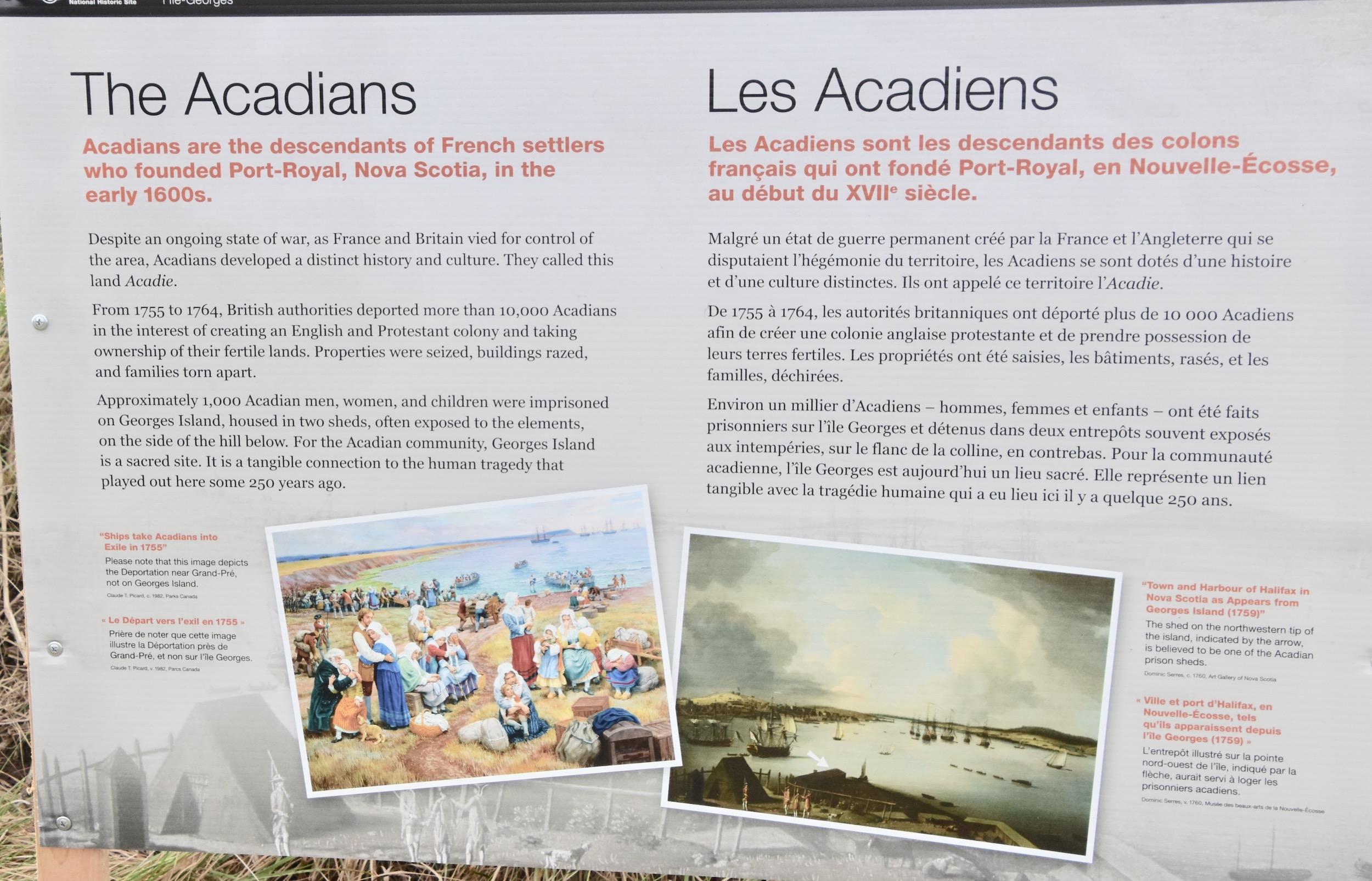
The end of the French/English struggle for control of North America did not mean an end to military preparedness on Georges Island. It became one of the most important parts of the Halifax Defence Complex which also included the Halifax Citadel, York Redoubt, Fort McNab and the Prince of Wales Martello Tower, all of which are now National Historic Sites administered by Parks Canada. The island saw service during the American Revolution, the Napoleonic Wars, the War of 1812 and WWI and WWII. However, after serving the area so well for hundreds of years, like a faithful old dog left behind when a miserable family moves away, it was deserted and left to the elements. Even the lighthouse, which was a beacon to shipping since 1876, was abandoned in 1972 and all trace of human activity virtually ceased.
However, the story has a happy ending.
Visiting Today
Plans to restore and reopen Georges Island to the public date back to 2009 when money was allocated for a new wharf and modernization of sewage, electrical and water systems. While as often happens, there were multiple delays, Georges Island finally reopened on August 6, 2020. The opening is quite limited for now – weekends only from 11:20 to 5:00 and will end for this year on September 6. While you may take your own boat to the island when it is open, the vast majority of visitors arrive by taking passage on The Harbour Queen which makes multiple trips back and forth on the weekends. Technically you can book tickets here by clicking on the Reserve Tickets Now button, but unfortunately for 2020 every remaining crossing is fully booked. However, given the popularity of the Georges Island ticket, I have no doubt that come the 2021 season we will see many more scheduled visits and everybody will get their chance to visit.
What follows is a description of my recent visit as a guest of Parks Canada along with a number of other travel journalists.
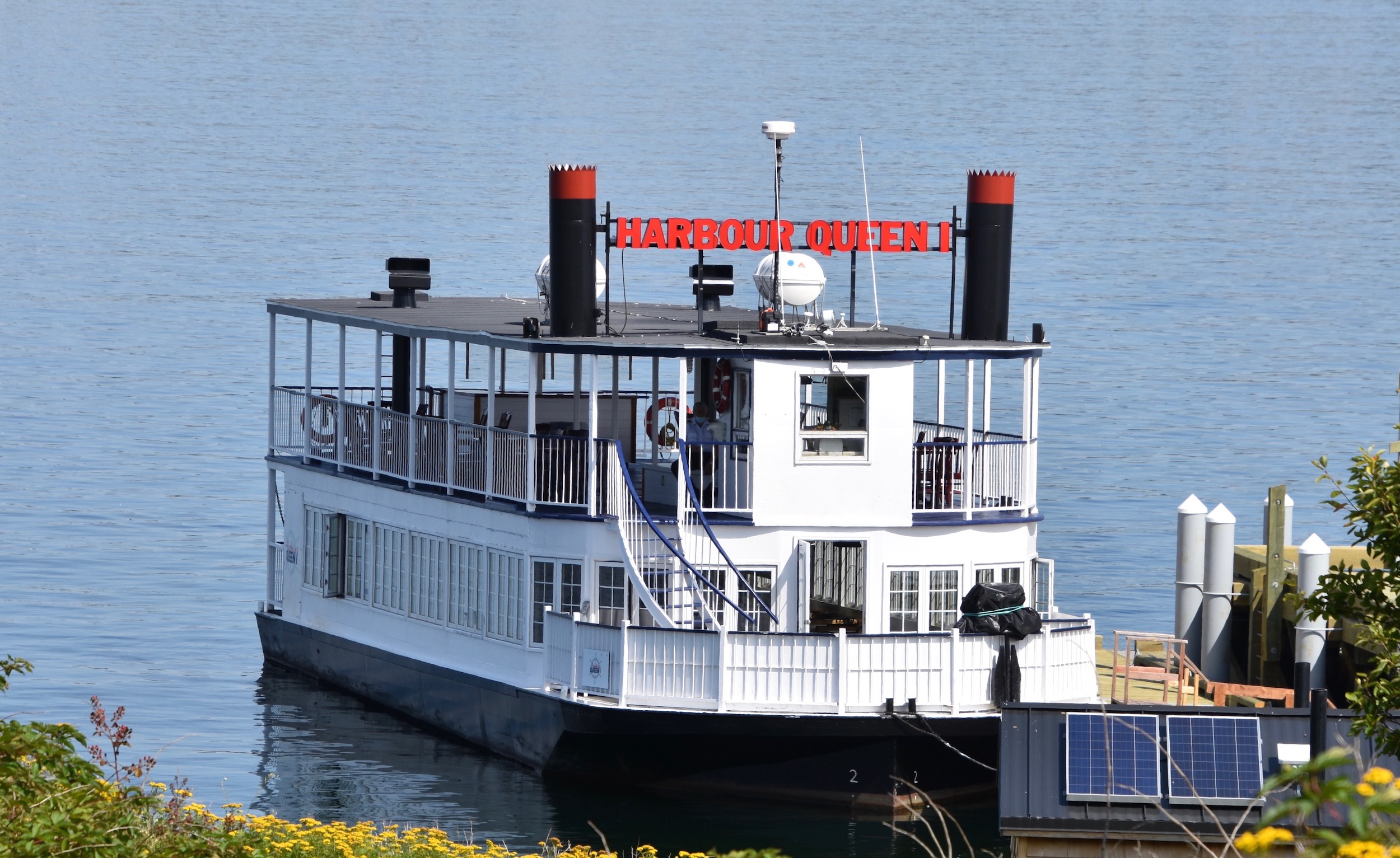
The Harbour Queen is a large faux paddle-wheeler expressly built for tourism purposes that has been plying the Halifax waterfront for decades, originally started by the Murphy family and recently sold to Ambassatours. It departs from the Cable Wharf and due to Covid restrictions masks are required to be worn while entering or remaining below decks. However, you may remove them if you go to the open air upper deck while maintaining social distancing. Hopefully these precautions will be a thing of the past by summer 2021.
The trip over is quite short and provides an excellent vantage point from which to view some of the sites on the Halifax waterfront such as the H.M.S.Sackville and the survey ship Acadia which are berthed outside the Maritime Museum of the Atlantic.
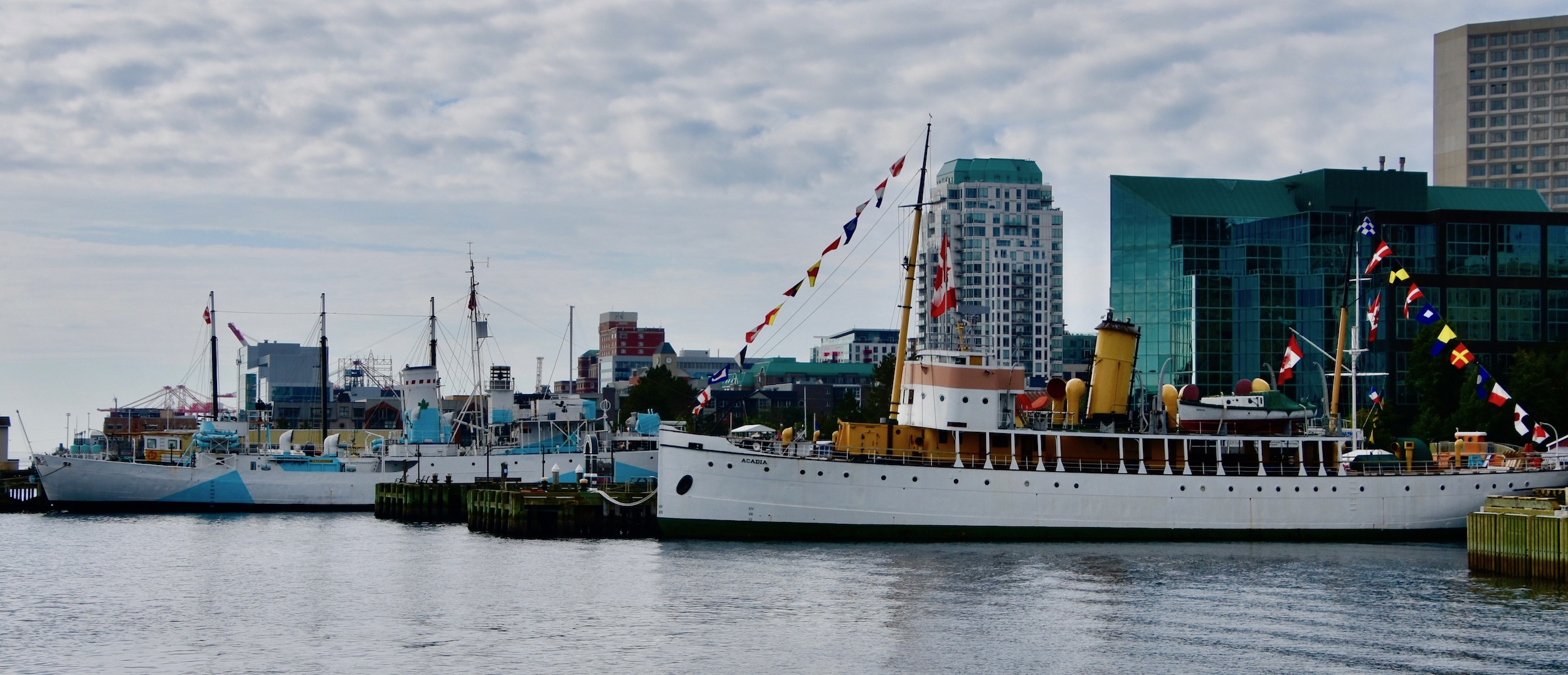
This is the view of Georges Island as you near the landing wharf to the left.
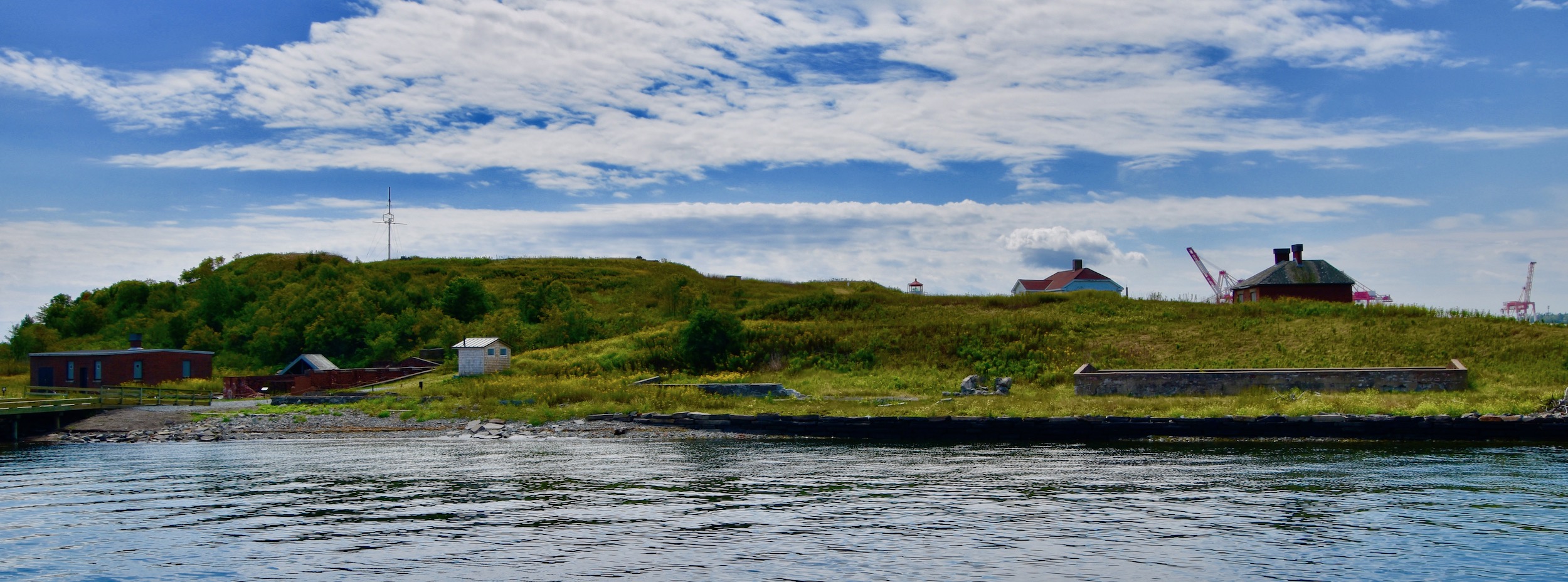
Upon boarding you will be provided with a map with 22 points of interest that you can explore at your leisure. There are also a number of interpretive panels such as the two above.
Our group was fortunate enough to have Mike Adams as our guide. He is one of the most knowledgable people on all things ‘Georges Island’ and is in the process of researching a book on the island’s tunnels and definitively answering one of the greatest mysteries connected with it – “Is there a tunnel connecting the island to the Halifax waterfront and possibly the Citadel?” You’ll have to wait until it comes out to get the answer. Today he is dressed as a private in the Cape Breton Highlanders regiment and starts our tour just after we step ashore. These are two of the massive muzzle loading rifled cannons that according to Mike were so accurate they could hit a target only a few feet wide from well over a kilometre away.
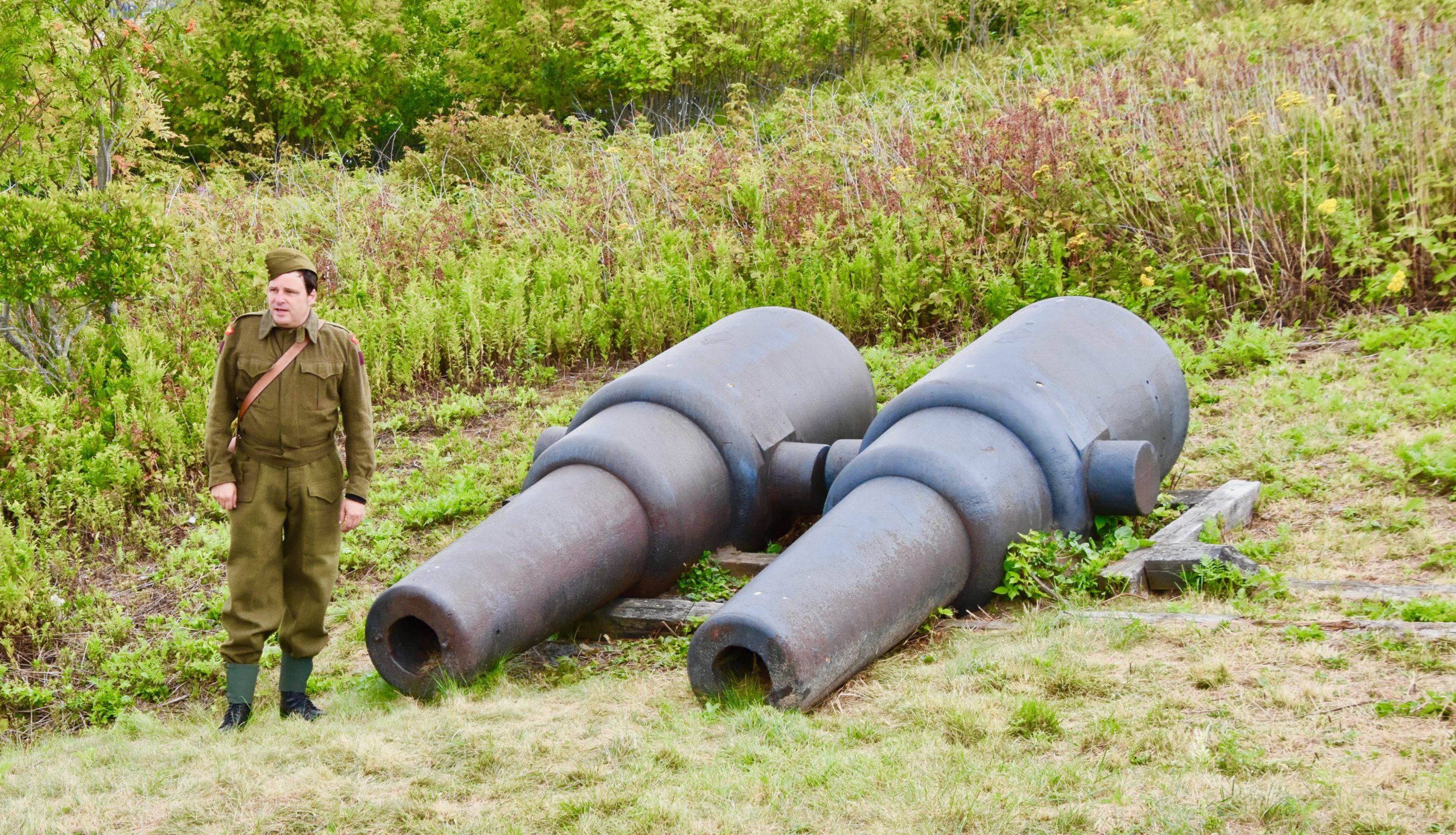
One of the latter defensive innovations on Georges Island was the construction of a submarine mines factory of which this is the remnant. The mines were designed to be placed underwater and used to blow up any enemy shipping that might pass over them by being detonated from a post on the island. Although they were never actually needed to be used, apparently test detonations were quite a thing to see and shook the ground for great distances.
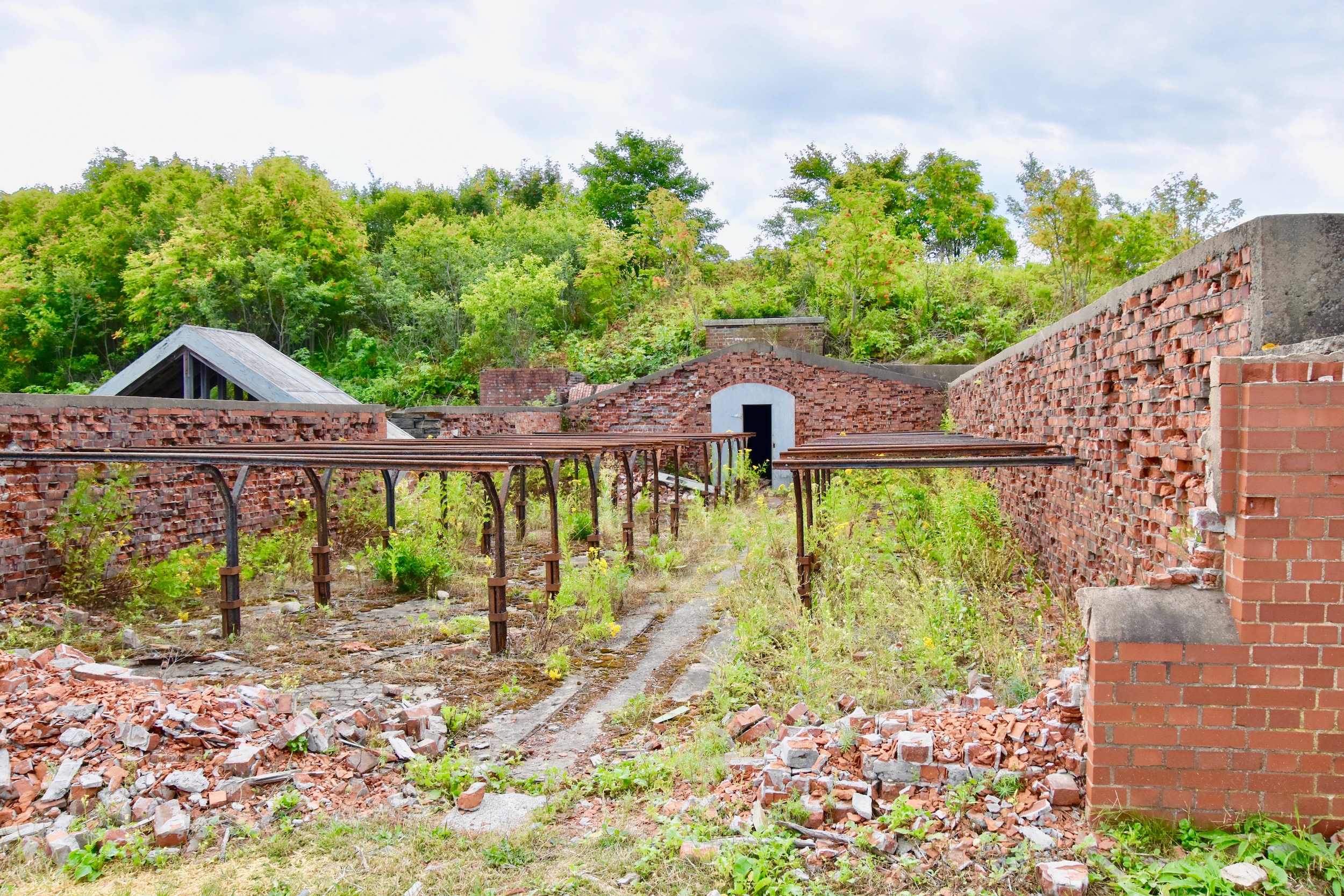
I’ve wondered for years what the buildings that you can see from the Halifax waterfront were used for and today I finally got the answer.
The red brick building is the former married officer’s quarters, built in 1901.
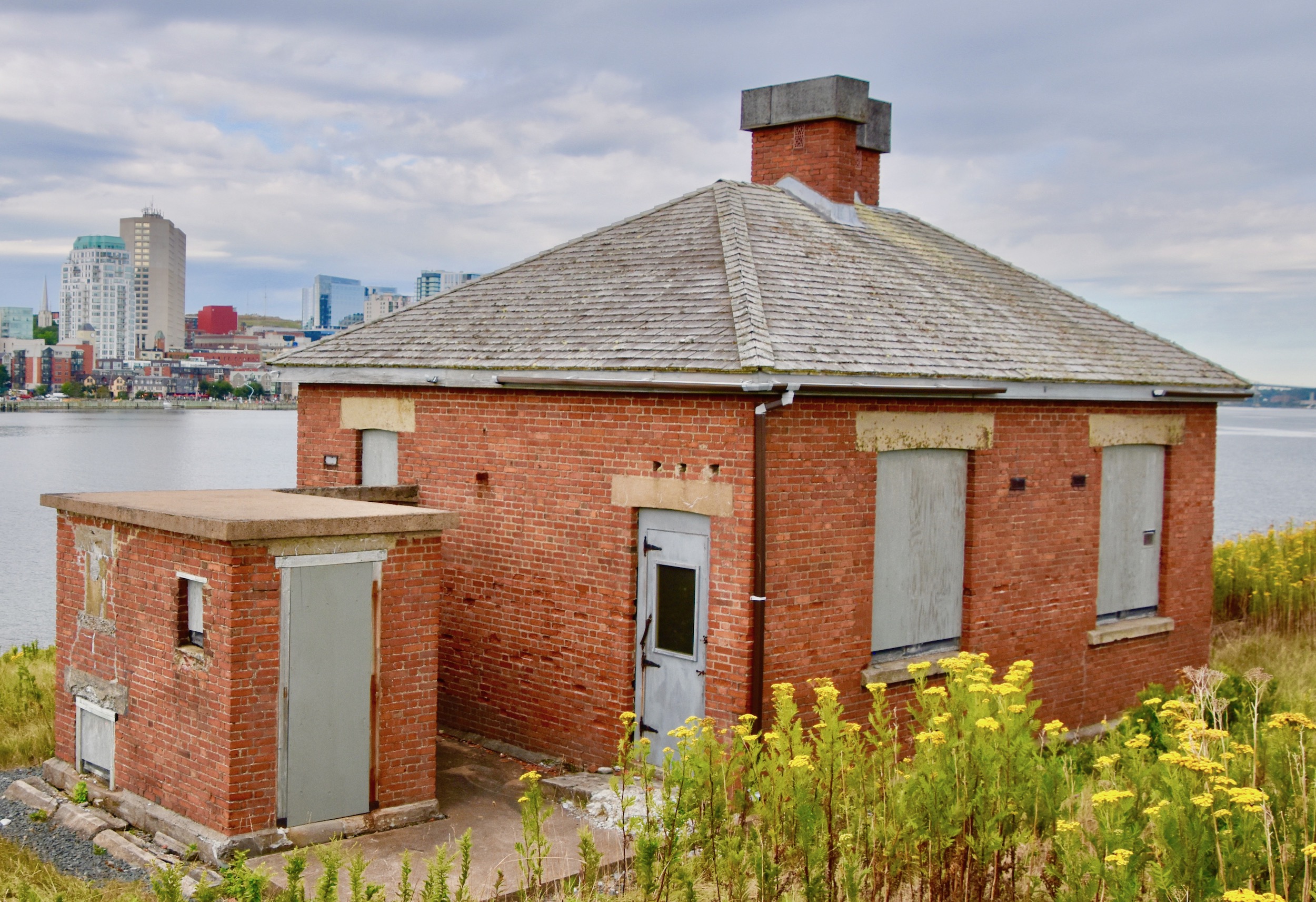
And the white building not far from it is the lighthouse keeper’s house that was occupied until 1972. There was a story in a recent CTV News broadcast about Dale Veinot who lived in this house from 1946 to 1964 while her father kept the Georges Island light. It sounded like and clearly was a very unique upbringing with the city both so close and yet so far removed from day to day life on the island.
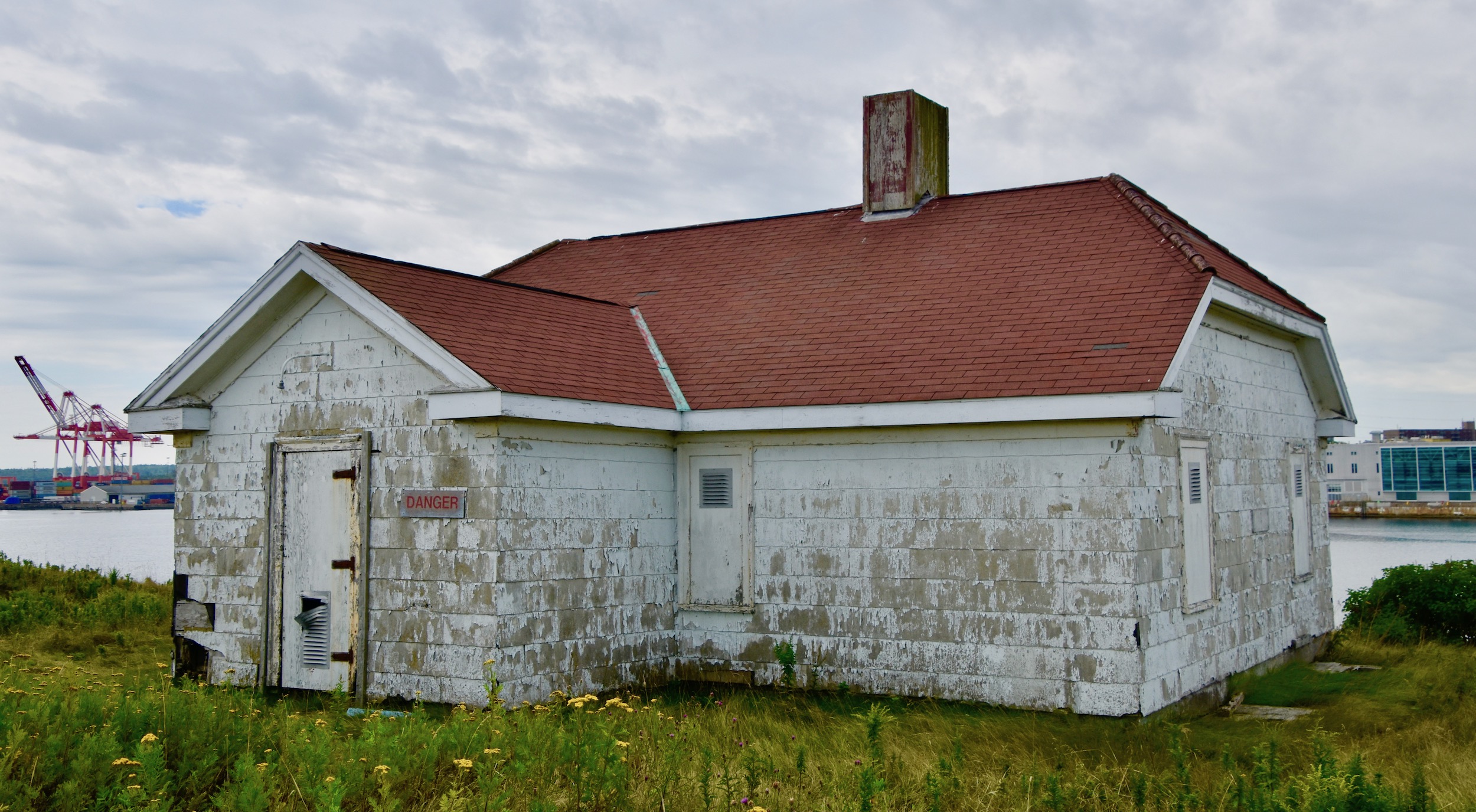
The lighthouse, now automated, still helps guide shipping in and out of the harbour. This is not the original one which burned down, but it did have its centennial birthday last year so its been around for quite a while. Behind it is Pier 21 where over a million immigrants would have seen the beacon on Georges Island and perhaps hoped that it was a symbol of a new and better life in Canada.
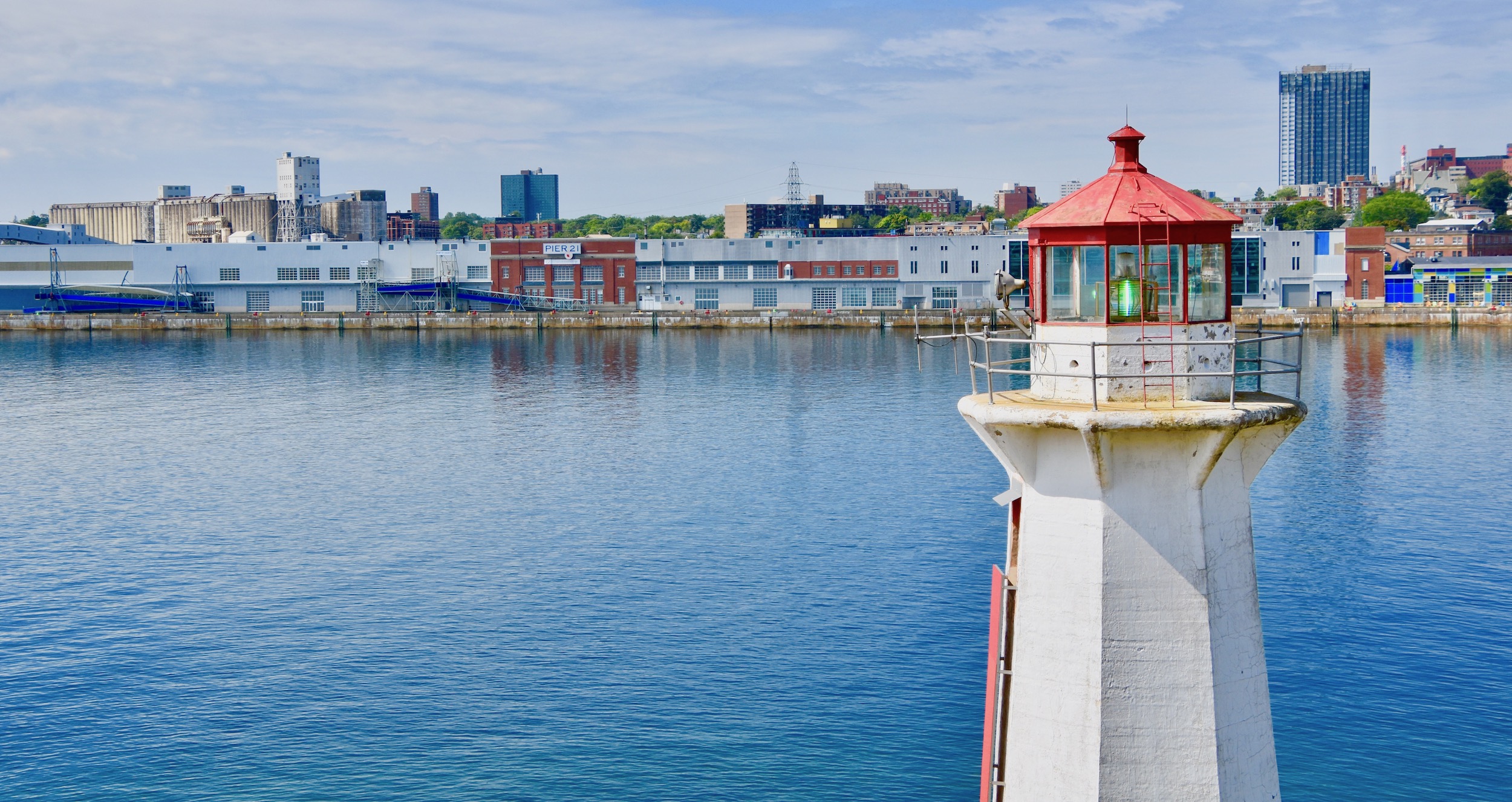
From near this vantage point you can also get a great view of the Halifax waterfront that is unique to Georges Island.

By now you will have climbed steadily up to the point that you are almost level with the top of the lighthouse. Here is the entrance to Fort Charlotte which occupies the entire top of Georges Island. Its construction dates back to one of the most prominent figures to ever reside in Halifax, Edward, Duke of Kent. He was responsible for the construction of our famous clock tower, the round Music Room on the Bedford Basin which is all that remains of his once palatial estate Prince’s Lodge and the architecturally beautiful St. George’s Church as well as much of the infrastructure that makes up the Halifax Defence Complex. He also happened to also be the father of Queen Victoria.
He named the fort after his mother Queen Charlotte. It is surrounded by a dry moat just as is the Halifax Citadel..
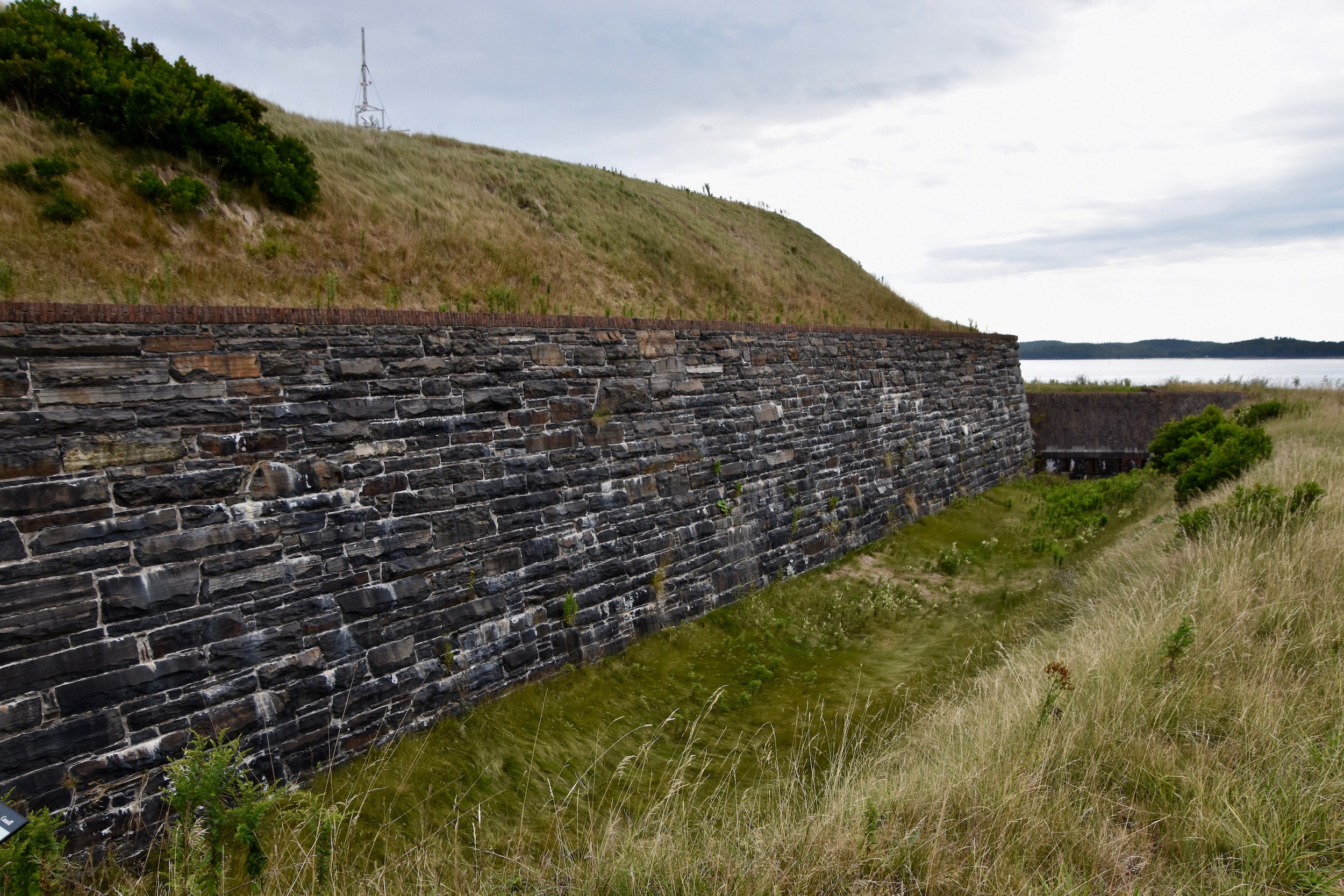
Just like the Halifax Citadel as well, you enter the fort by way of a drawbridge that would pulled up in the event of an attack, but again like the Citadel, nobody was brave or perhaps crazy enough to try to penetrate the gauntlet of fortifications that made Halifax harbour one of the most secure in the world. As Mike pointed out, as long as Halifax harbour was secure, so was the rest of Maritime Canada.
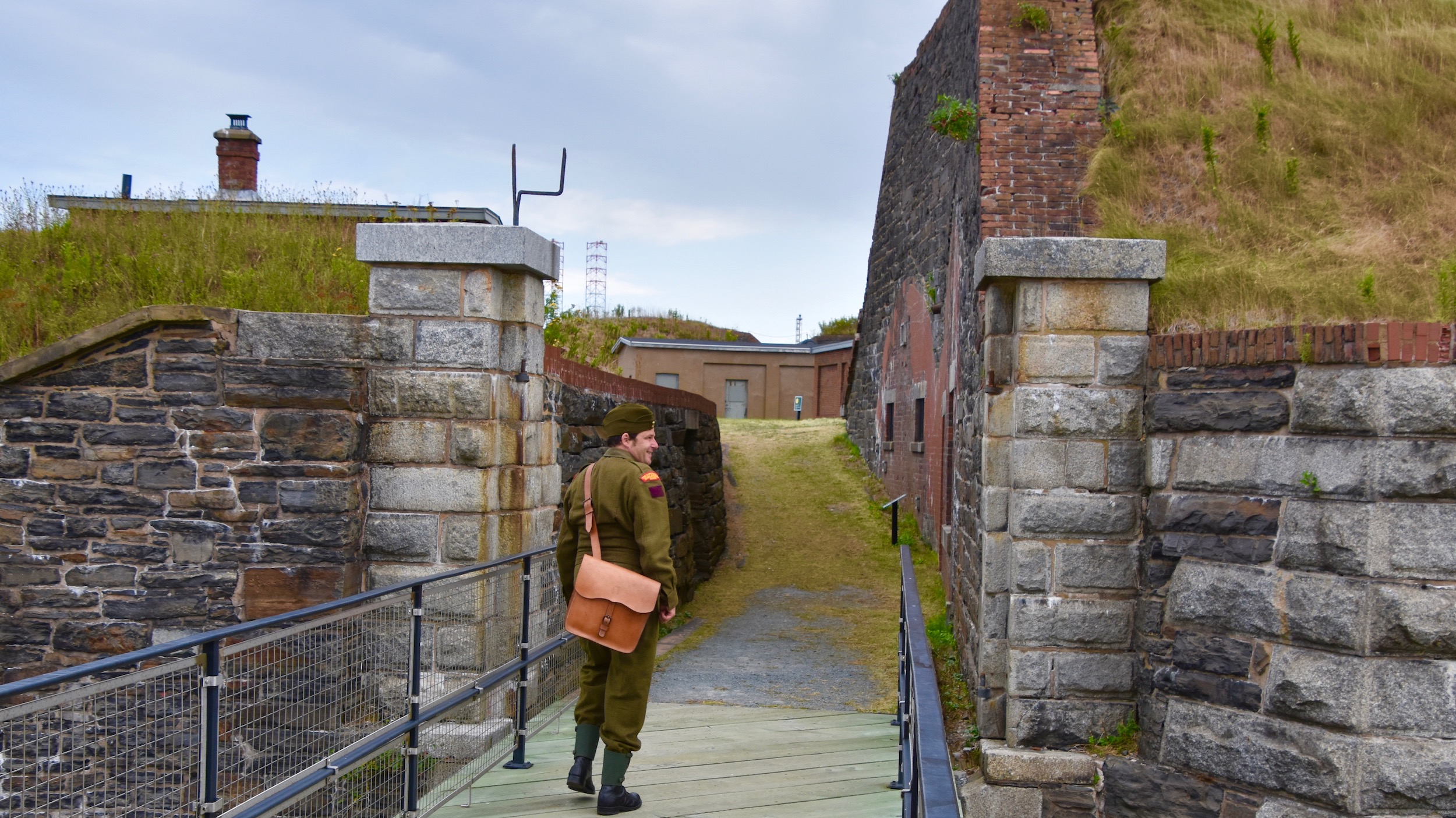
Like almost all forts, there is a guard house at the entrance which also doubled as a jail for unruly soldiers or captured prisoners. During the War of 1812 a number of captured American privateers were held prisoner here. Richard Lovelace may have written that “Stone walls do not a prison make, nor iron bars a cage”, but I’d beg to differ in the case of Fort Charlotte.
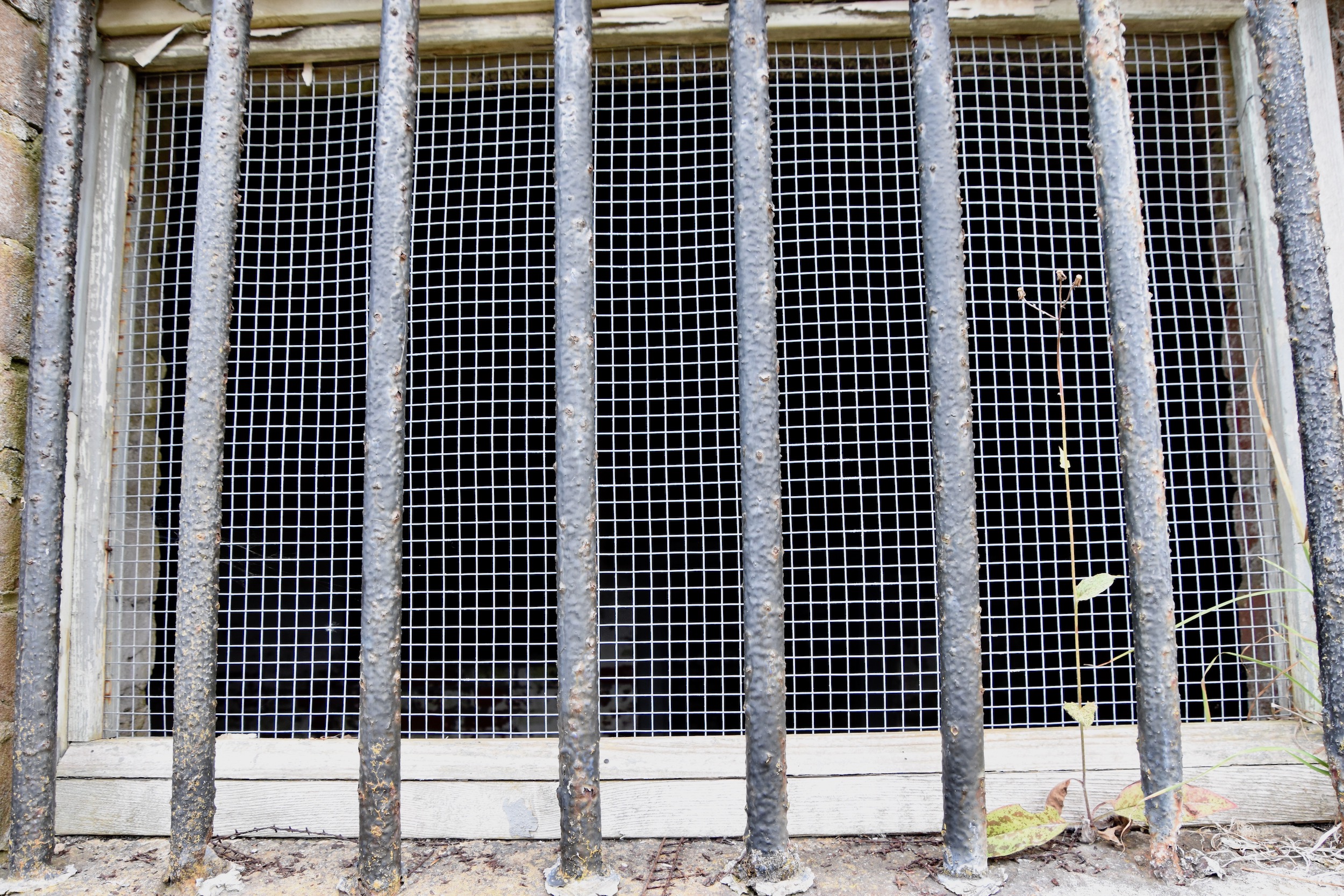
Past the guard room the fort opens to a small parade square with the remnants of the North Battery. Unlike the French at Louisbourg who had their artillery positioned only to defend an attack from the seaward side, on Fort Charlotte all four directions are covered.
This is the entrance to the famed Georges Island tunnels of which there are free guided tours offered by Parks Canada. You are required to put your masks back on while inside. As tunnels go these are quite well lit and fairly wide so that claustrophobia shouldn’t be an issue like it can be in some places such as the Barbados Barracks in Bridgetown.
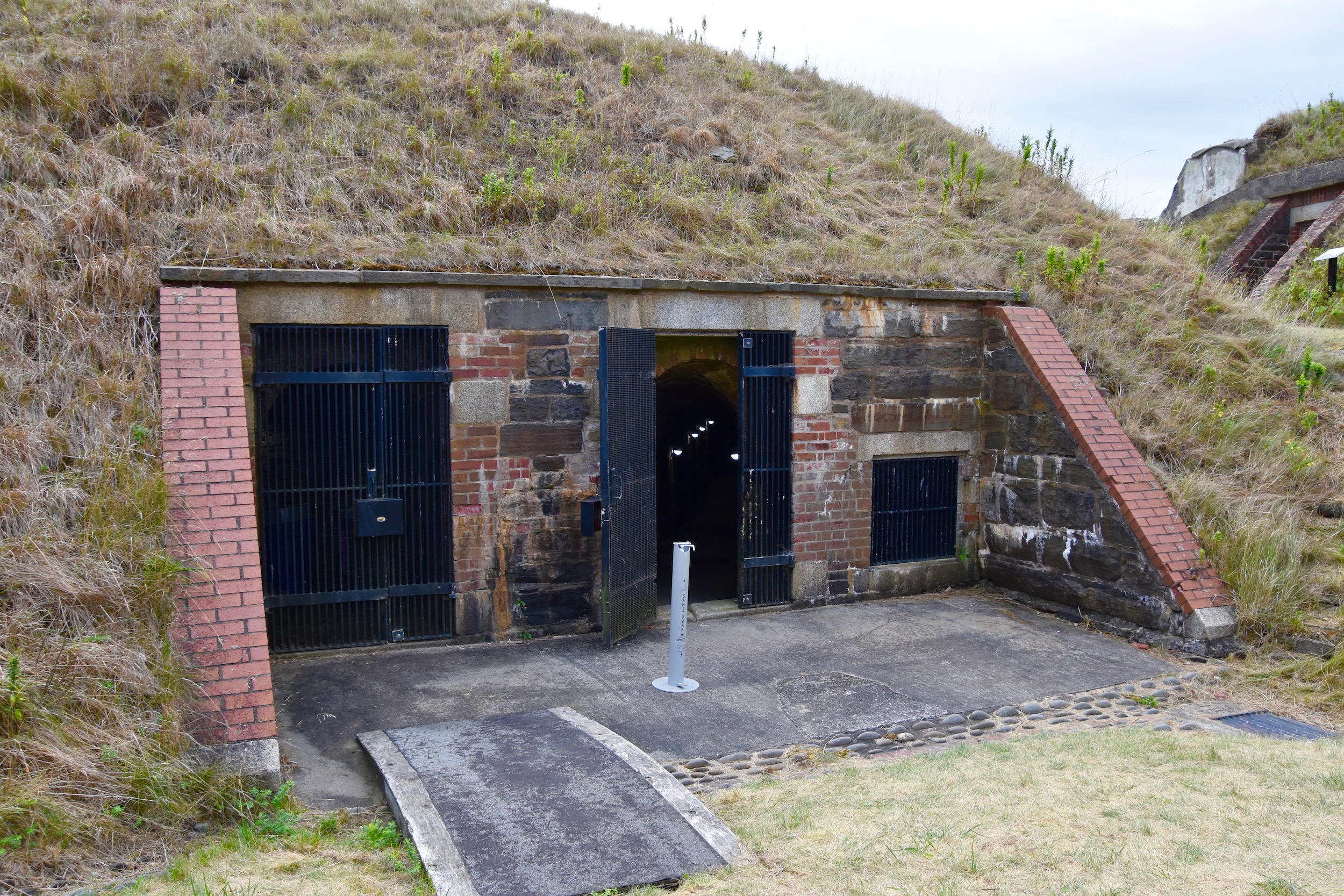
This is as about as narrow as they get and trust me, without a guide you would feel like a rat in a maze.
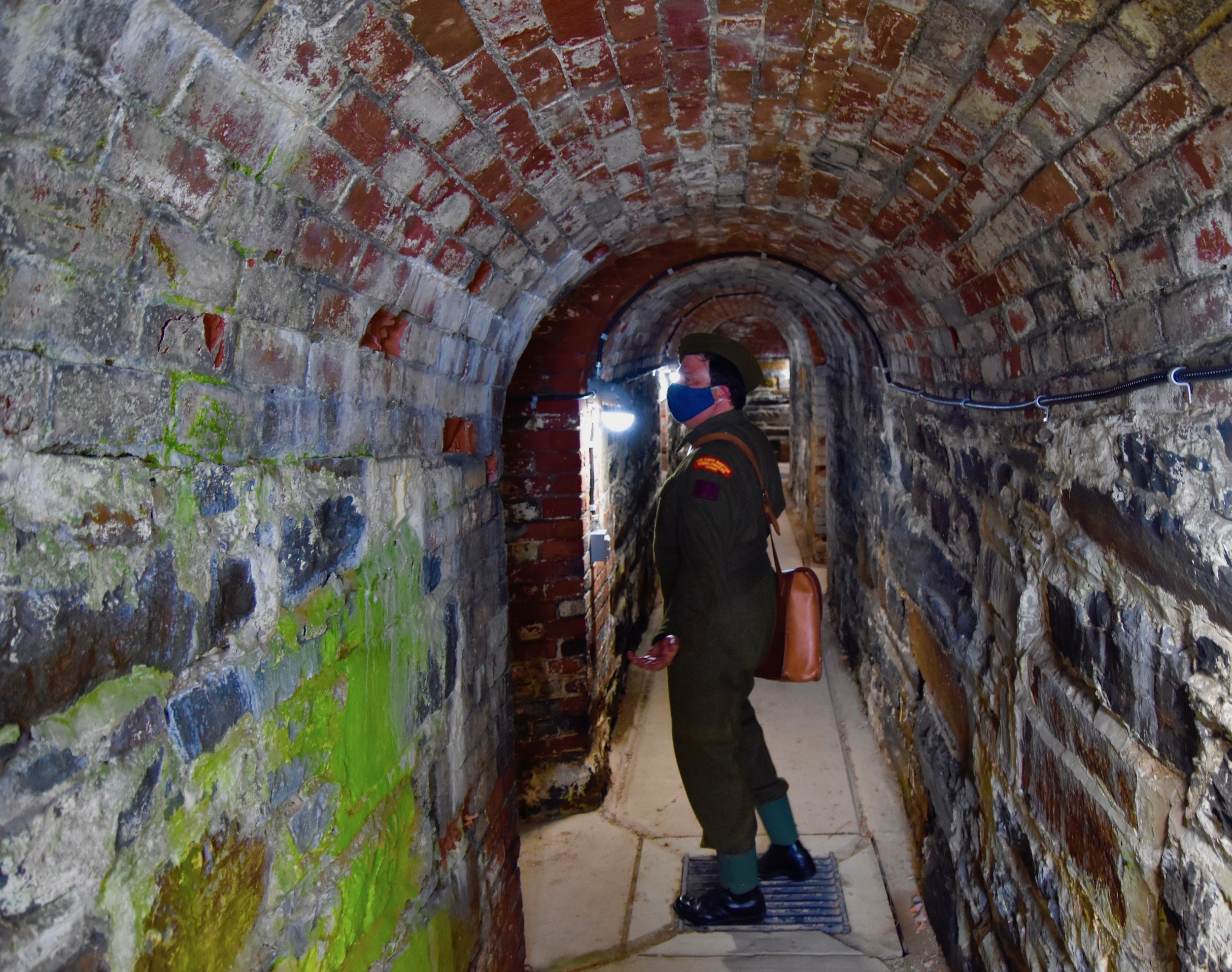
The primary purpose of these tunnels was to store munitions well away from enemy shells and to provide places from which to defend an attack. These latter are called caponiers which are narrow slits through which soldiers could fire on attackers who managed to get over the walls and would then find themselves trapped in a killing field. There are about eight of them on each side of this tunnel.
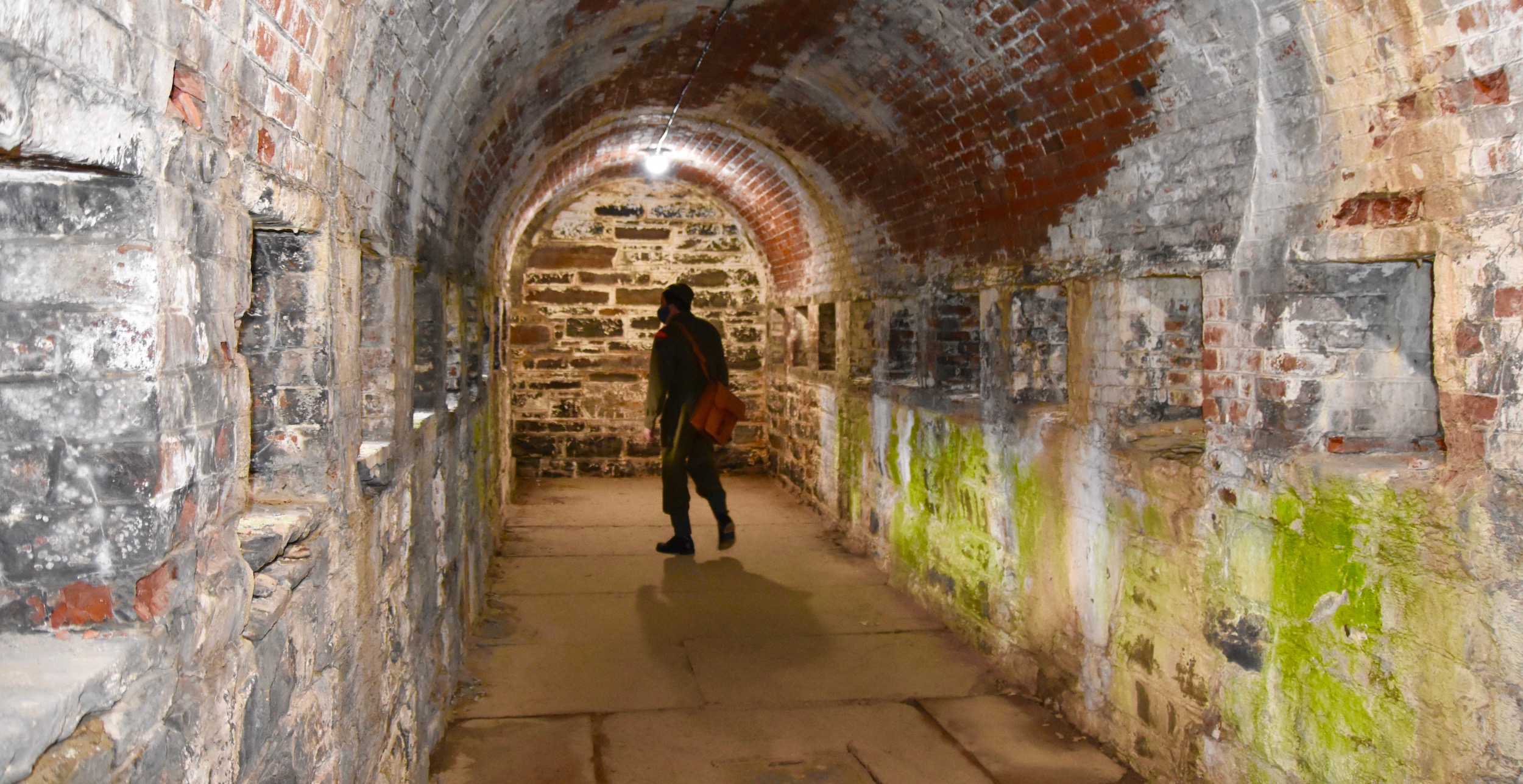
This is the primary storage room for munitions and other supplies needed to man the batteries.
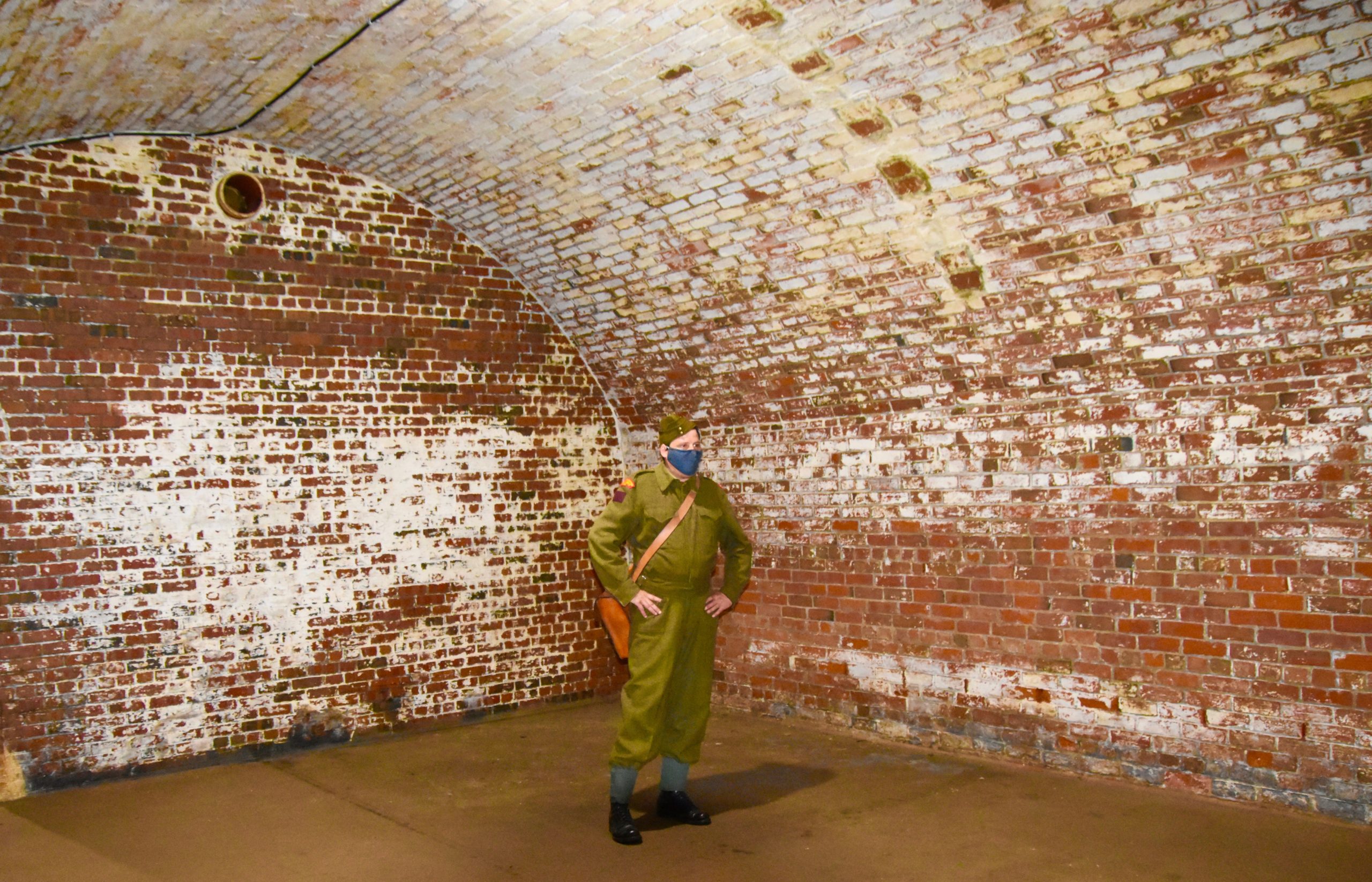
After passing by the caponiers you go outside once more, but in between the inner and outer walls. This is where enemies who got over the outer wall would find themselves trapped and either have to retreat or try to advance in the face of the rifle fire from the caponiers.
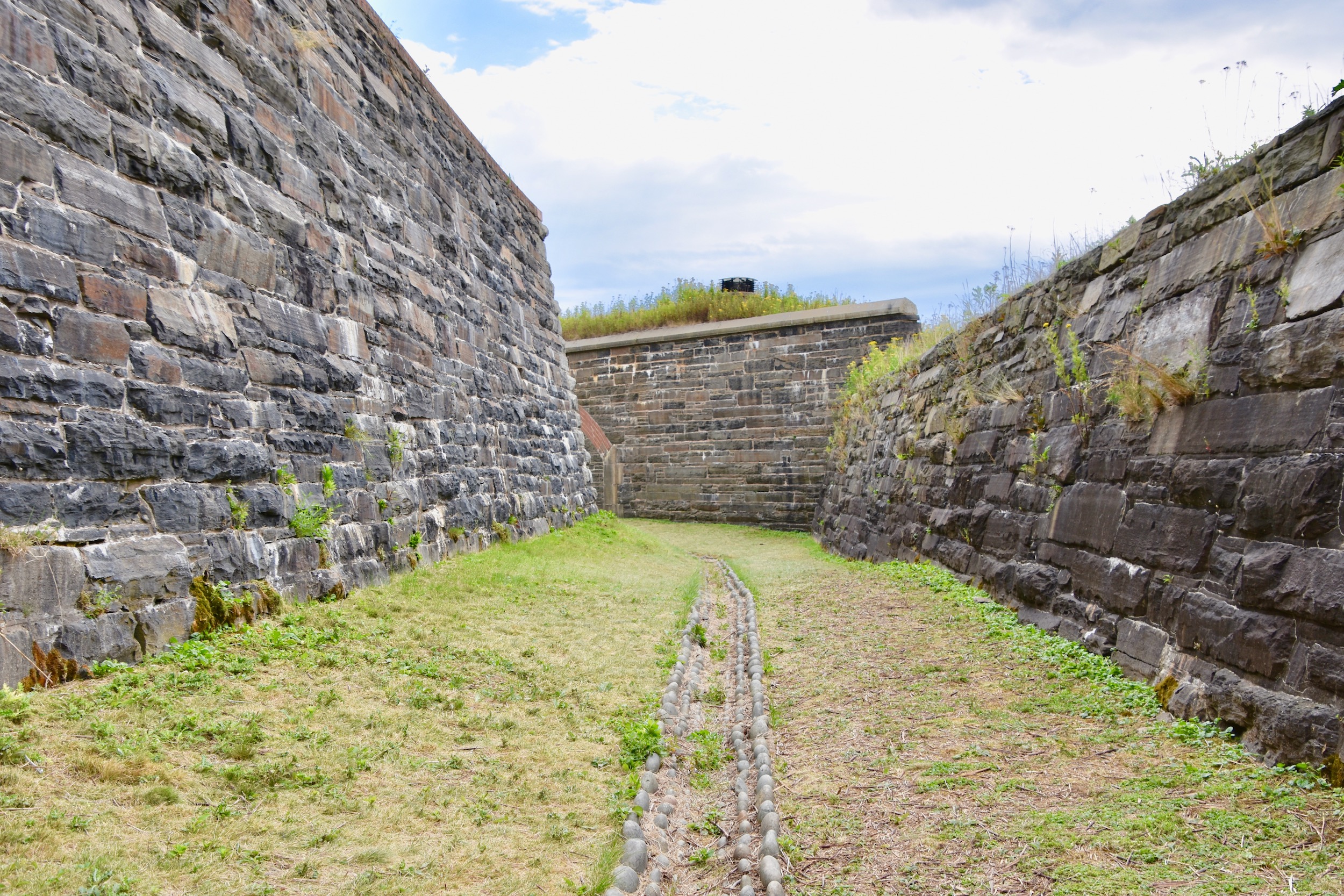
Georges Island isn’t just about history. It is covered with a blanket of grasses and wildflowers that make it the perfect home for mice and voles of which there are plenty. Normally quite shy, the rodents here like this meadow vole, do not scurry away at the first sight of a human being, but just stare back, evidently as curious to see people around as we are to see them.

This is the entrance to the lower battery which contains four massive RML 10 inch guns from the Woolwich arsenal south of London.
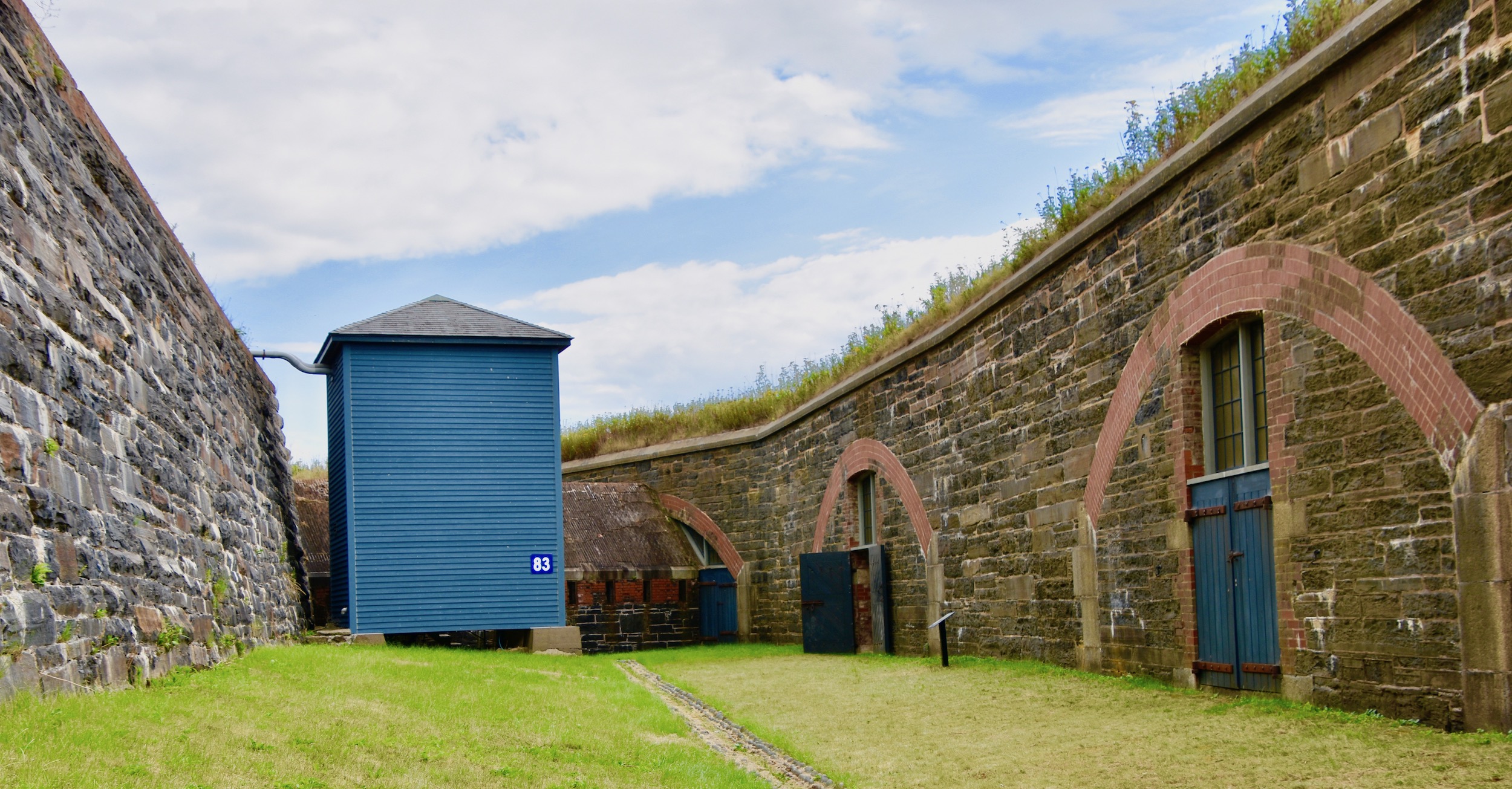
The guns were aimed squarely at the entrance to the harbour and could blow anything out of the water that tried to breach the harbour entrance from a securely protected position inside Georges Island.
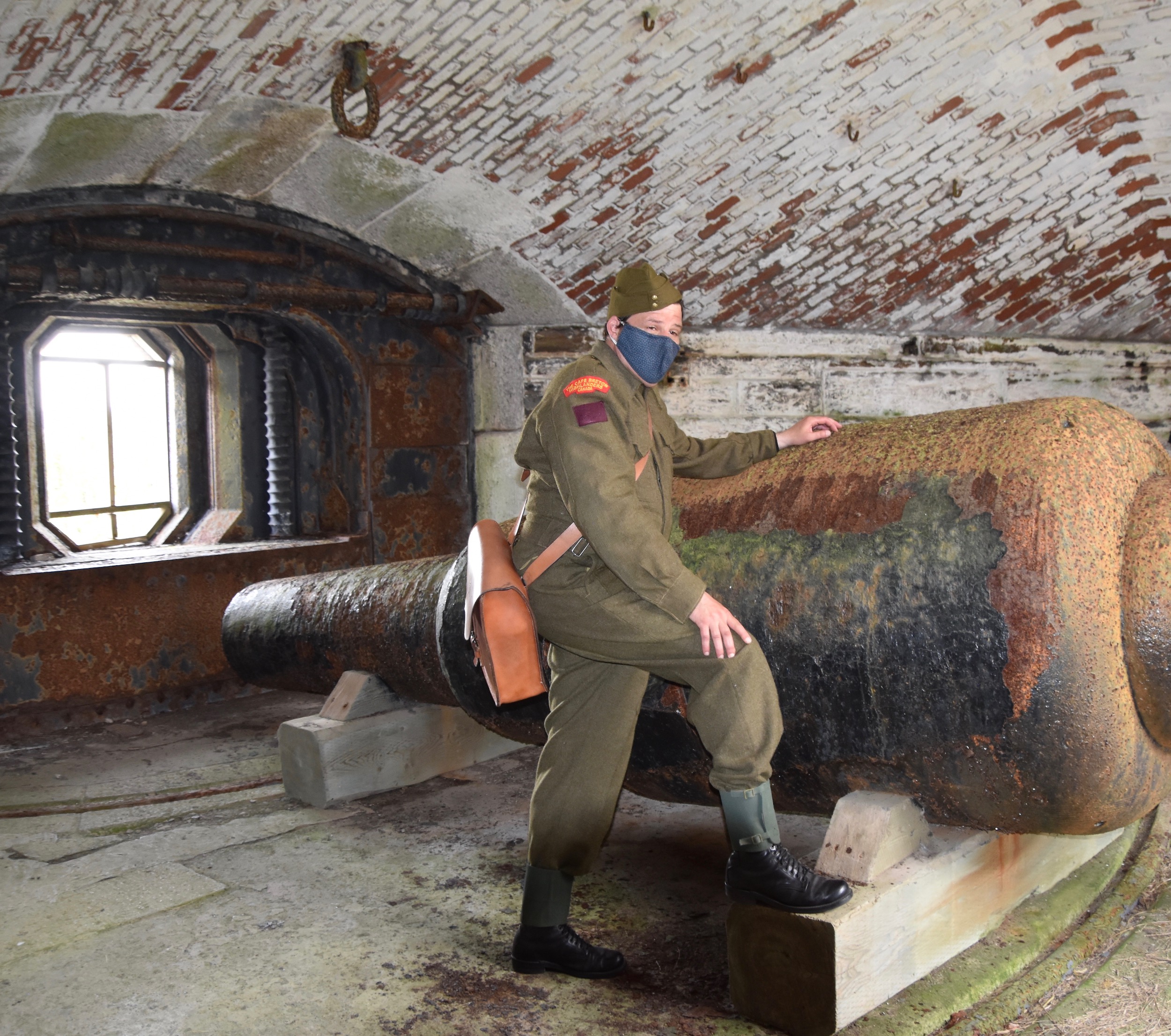
You leave the tunnels via a stairway that you might have to share with another of Georges Island famous denizens – its harmless garter snakes.
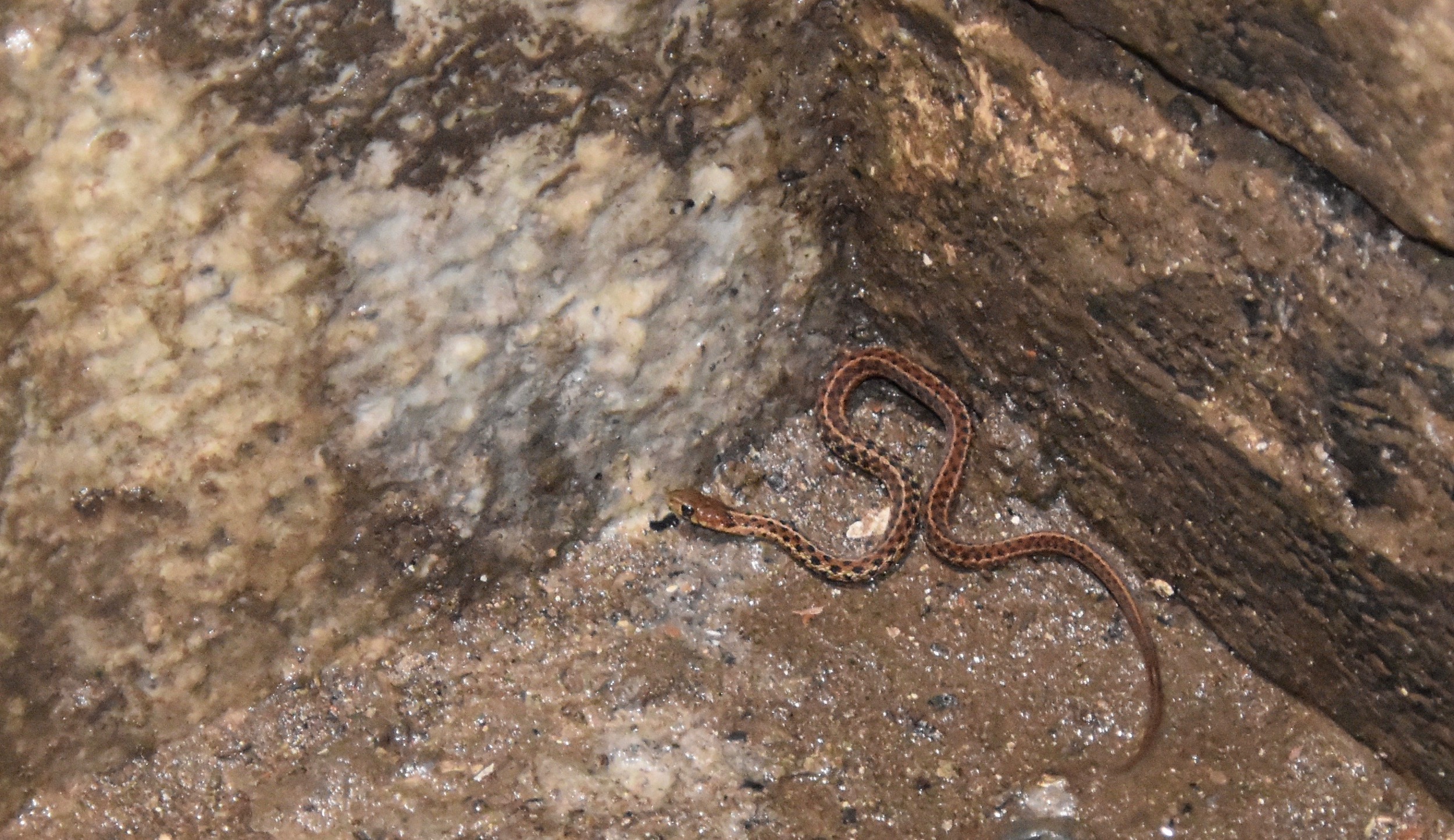
Above the Lower Battery sits the Upper Battery which was comprised of eight nine inch RML guns that are laid out in a horseshoe configuration. Between the two harbour facing batteries there was enough firepower to sink the most modern of ‘ironclads’ from three kilometres away. Having been to the other four fortifications that make up the Halifax Defence Complex, visiting Georges Island was like the final piece of the puzzle come together to explain why the harbour was never seriously threatened.
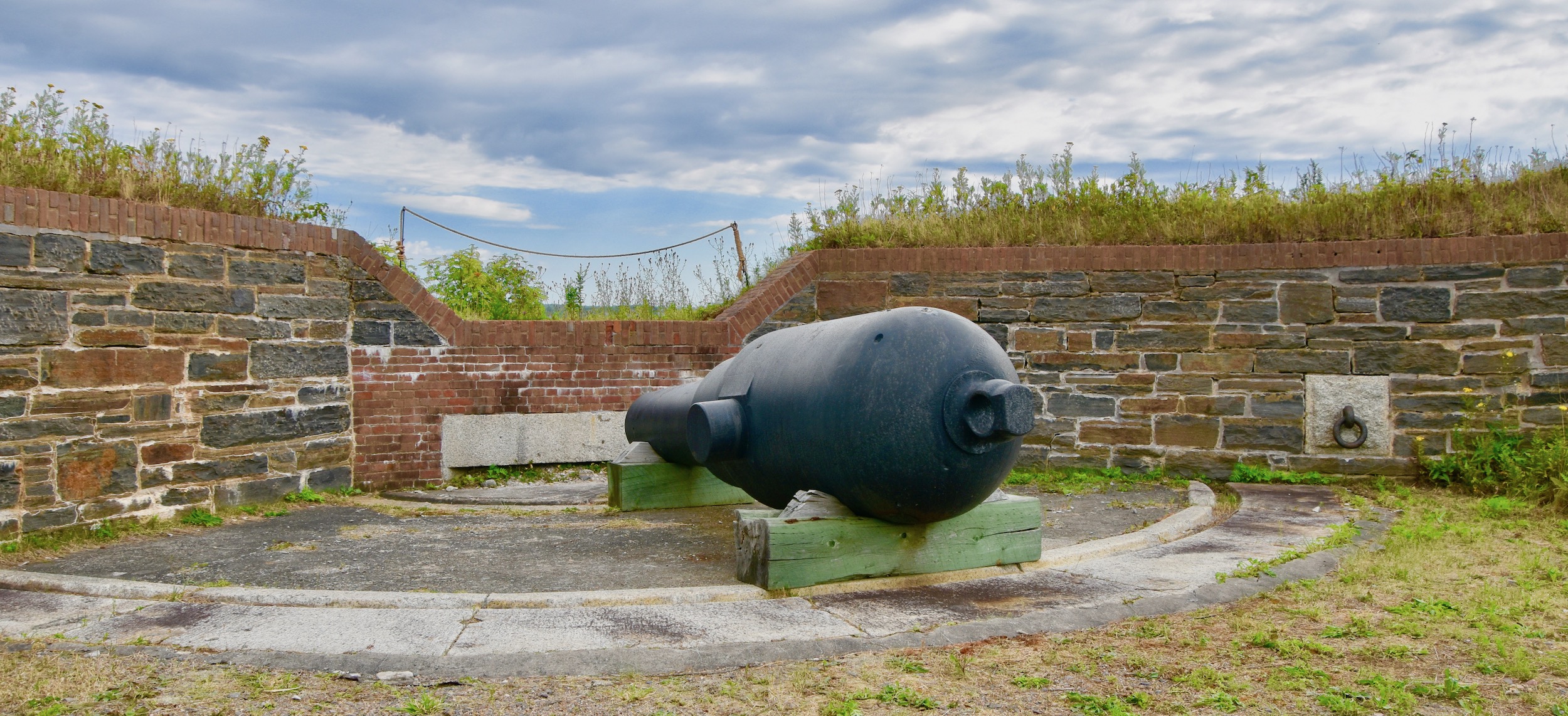
Coming down from the upper battery takes you back to the parade square from where you make your way back down to the landing wharf.
However, the final stop should be in one of Parks Canada’s red chairs, looking out over the Halifax skyline from a place you probably thought you’d never be.
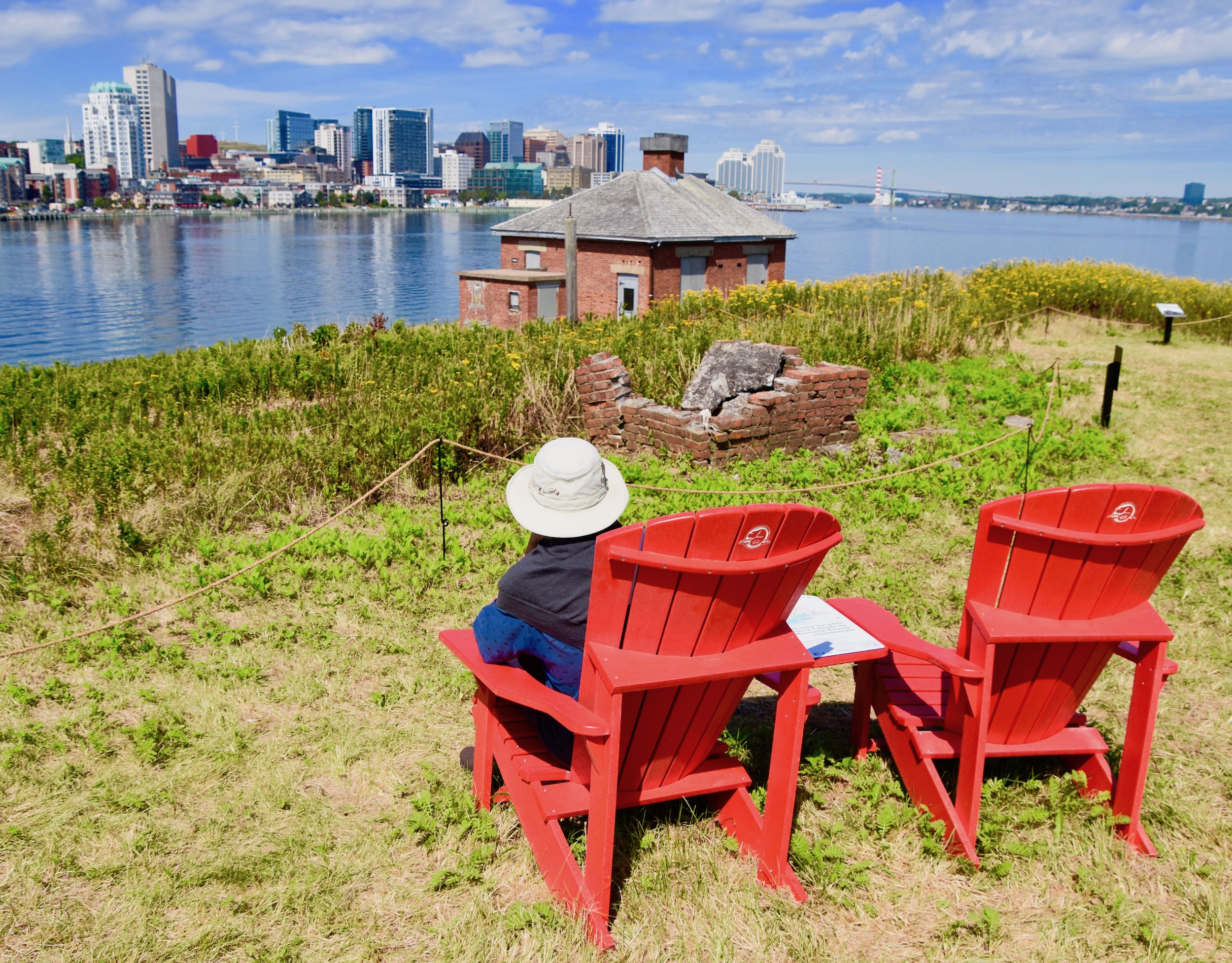
Again, thanks to my friends at Parks Canada for making it possible not just for me, but to all members of the public to visit this great National Historic Site.
For another post on the Halifax Defence Complex check out out York Redoubt.

